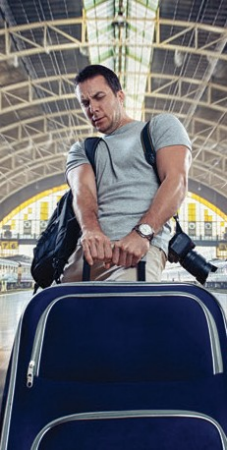The summer is right around the corner, which often means an influx of travelers and lots of heavy luggage. The larger and heavier your luggage, the more at risk you are for neck, back, and shoulder injuries. Bone, muscle, and joint strain caused by improper handling of heavy luggage are more common than you may think.
According to the U.S. Consumer Product Safety Commission, more than 85,000 people were treated in emergency rooms, doctors’ offices, and clinics for injuries related to luggage in 2017.
Don’t let suitcase strain ruin your summer vacation fun. The American Academy of Orthopaedic Surgeons (AAOS) encourages travelers to follow these safety tips to avoid injury when carrying bulky bags this holiday season.
EXPERT ADVICE
“Hurting your neck, back, or shoulders can put you out of commission for a long time,” said AAOS spokesperson and orthopaedic spine surgeon Charla Fischer, MD. “You can prevent that by packing lightly, using sturdy luggage with wheels and handles, and using good form when carrying or lifting bags.”
The AAOS offers the following advice for lifting and carrying luggage:
• Avoid purchasing luggage that is too heavy or bulky when empty.
• Use smart packing techniques. When possible, place items in a few smaller bags instead of one large luggage piece.
• To lift luggage, stand alongside of it and bend at the knees. Try to limit bending at the waist. Lift the luggage with your leg muscles. Grasp the handle and straighten up. Once you lift the luggage, hold it close to your body.
• Do not twist when lifting and carrying luggage. Point your toes in the direction you are headed and turn your entire body in that direction.
• Do not rush when lifting or carrying a suitcase. If it is too cumbersome, get help.
• Do not carry bulky luggage for long periods of time. When possible, use the airline’s baggage service when traveling with heavier items.
• Carry pieces in both of your hands rather than one hand off to the side. This can decrease stress to the spine. Less weight on any one arm can also reduce the risk of developing “suitcase elbow,” a chronic condition similar to “tennis elbow.”
• When placing luggage in an overhead compartment, first lift it onto the top of the seat. Place your hands on the left and right sides of the suitcase and lift it up. If your luggage has wheels, make sure the wheel-side is set in the compartment first. Once wheels are inside, put one hand atop the luggage and push it to the back of the compartment. To remove the luggage, reverse this process.
• When using a backpack, make sure it has two padded and adjustable shoulder straps to equally balance the weight. Choose a backpack with several compartments to secure various-sized items, packing the heavier things low and towards the center. Slinging a backpack over one shoulder does not allow weight to be distributed evenly. This can cause muscle strain.
• When using a duffel or shoulder bag, do not carry it on one shoulder for any length of time. Be sure to switch sides often.
• Do not drag rolling luggage when climbing stairs–carry it instead.
With more than 38,000 members, the American Academy of Orthopaedic Surgeons is the world’s largest medical association of musculoskeletal specialists. The AAOS provides educational programs for orthopaedic surgeons and allied health professionals, champions and advances the highest quality musculoskeletal care for patients, and is the authoritative source of information on bone and joint conditions, treatments and related issues. For a guide to safety for lifting and carrying luggage, visit OrthoInfo.org.

